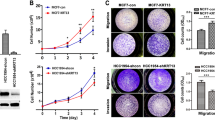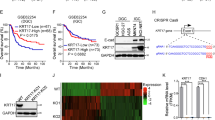Abstract
The cytokeratin 8/18 (CK8/18) cytoskeleton network is an early target for caspase cleavage during apoptosis. Recent reports suggest that the highly conserved and ubiquitous death effector domain containing DNA binding protein (DEDD) plays a role in the recruitment of procaspase-9 and -3 at this CK8/18 scaffold. DEDD interacts with both the CK8/18 intermediate filament network and procaspase-3 and –9. It is suggested that the CK8/18 fibrils may provide a scaffold for the proximity-induced autocleavage and activation of procaspase-9 in close association with caspase-3.
We addressed this issue by investigating DEDD staining patterns in various cell lines and by correlating these expression patterns with the sensitivity of these cell lines for roscovitine-induced apoptosis. We showed that in some cell lines DEDD revealed a bright filamentous staining pattern in others DEDD staining was weak and diffusely distributed in the cytoplasm of the cells. The difference in staining patterns was irrespective of the phosphorylation status of the cytokeratin filaments. In cells showing a filamentous staining pattern, DEDD was strongly associated with the CK8/18 cytokeratin filaments as evidenced by double immunofluorescence and its resistance to extraction with Triton X-100. Subcellular fractionation indicates that DEDD co-purifies with CK18, which corroborates a strong association of DEDD and the cytokeratin network. DEDD was either mono- or diubiquinated. Cells showing a filamentous DEDD distribution are more apoptosis-prone as evidenced by the rapid appearance of M30 CytoDeath-positive cells after induction of apoptosis. The sensitivity towards apoptosis is irrespective of the procaspase-3 content of the cells. Our data support the notion that DEDD-mediated accumulation of procaspases at the cytokeratin scaffold leads to an increase in the local concentration, which renders cells more apoptosis-prone.
Similar content being viewed by others
References
van Engeland M, Kuijpers HJ, Ramaekers FCS, Reutelingsperger CP, Schutte B (1997) Plasma membrane alterations and cytoskeletal changes in apoptosis. Exp Cell Res 235:421–430
Leers MP, Kölgen W, Björklund V, Bergman T, Tribbick G, Persson B, Björklund P, Ramaekers FCS, Björklund B, Nap M, Jörnvall H, Schutte B (1999) Immunocytochemical detection and mapping of a cytokeratin 18 neo-epitope exposed during early apoptosis. J Pathol 187:567–572
Schutte B, Henfling M, Kölgen W, Bouman M, Meex S, Leers MPG, Nap M, Björklund V, Björklund P, Björklund B, Lane EB, Bishr Omary M, Jörnvall H, Ramaekers FCS (2004) Keratin 8/18 breakdown and reorganization during apoptosis. Exp Cell Res 297:11–26
Oshima RG (2002) Apoptosis and keratin intermediate filaments. Cell Death Differ 9:486–492
Caulin C, Salvesen GS, Oshima RG (1997) Caspase cleavage of keratin 18 and reorganization of intermediate filaments during epithelial cell apoptosis. J Cell Biol 138:1379–1394
Lee JC, Schickling O, Stegh AH, Oshima RG, Dinsdale D, Cohen GM, Peter ME (2002) DEDD regulates degradation of intermediate filaments during apoptosis. J Cell Biol 158:1051–1066
Dinsdale D, Lee JC, Dewson G, Cohen GM, Peter ME (2004) Intermediate filaments control the intracellular distribution of caspases during apoptosis. Am J Pathol 164:395–407
Thornberry NA, Lazebnik Y (1998) Caspases: Enemies Within. Science 281:1312–1316
Srinivasula S, Ahmad M, Fernandes-Alnemri T, Alnemri E (1998) Autoactivation of procaspase-9 by Apaf-1-mediated oligomerization. Mol Cell 1:949–957
Bratton S, Lewis J, Butterworth M, Duckett C, Cohen G (2002) XIAP inhibition of caspase-3 preserves its association with the Apaf-1 apoptosome and prevents CD95- and Bax-induced apoptosis. Cell Death Differ 9:881–892
Srinivasula SM, Hegde R, Saleh A, Datta P, Shiozaki E, Chai J, Lee R-A, Robbins PD, Fernandes-Alnemri T, Shi Y, Alnemri ES (2001) A conserved XIAP-interaction motif in caspase-9 and Smac/DIABLO regulates caspase activity and apoptosis. Nature 410:112–116
Holcik M, Korneluk R (2001) XIAP, the guardian angel. Nat Rev Mol Cell Biol. 2:550–556
Schickling O, Stegh A, Byrd J, Peter M (2001) Nuclear localization of DEDD leads to caspase-6 activation through its death effector domain and inhibition of RNA polymerase I dependent transcription. Cell Death Differ 8:1157–1168
Renatus M, Stennicke HR, Scott FL, Liddington RC, Salvesen GS (2001) Dimer formation drives the activation of the cell death protease caspase 9. PNAS 98:14250–14255
Stumptner C, Omary MB, Fickert P, Denk H, Zatloukal K (2000) Hepatocyte Cytokeratins Are Hyperphosphorylated at Multiple Sites in Human Alcoholic Hepatitis and in a Mallory Body Mouse Model. Am J Pathol 156:77–90
Lee J, Wang G, Schickling O, Peter M (2005) Fusing DEDD with ubiquitin changes its intracellular localization and apoptotic potential. Apoptosis 10:1483–1495
Laemmli UK (1970) Cleavage of structural proteins during the assembly of the head of bacteriophage T4. Nature 227:680–685
Towbin H, Staehelin T, Gordon J (1979) Electrophoretic transfer of proteins from polyacrylamide gels to nitrocellulose sheets: procedure and some applications. Proc Natl Acad Sci USA 76:4350–4354
Janicke RU, Sprengart ML, Wati MR, Porter AG (1998) Caspase-3 Is required for DNA fragmentation and morphological changes associated with apoptosis. J Biol Chem 273:9357–9360
Oberhammer F, Hochegger K, Froschl G, Tiefenbacher R, Pavelka M (1994) Chromatin condensation during apoptosis is accompanied by degradation of lamin A and B, without enhanced activation of cdc2 kinase. J Cell Biol 126:827–837
Guo Y, Srinivasula SM, Druilhe A, Fernandes-Alnemri T, Alnemri ES (2002) Caspase-2 induces apoptosis by releasing proapoptotic proteins from mitochondria. J Biol Chem 277:13430–13437
Robertson JD, Enoksson M, Suomela M, Zhivotovsky B, Orrenius S (2002) Caspase-2 acts upstream of mitochondria to promote cytochrome c release during etoposide-induced apoptosis. J Biol Chem 277:29803–29809
McManus D, Lefebvre C, Cherton-Horvat G, St-Jean M, Kandimalla E, Agrawal S, Morris S, Durkin J, Lacasse E (2004) Loss of XIAP protein expression by RNAi and antisense approaches sensitizes cancer cells to functionally diverse chemotherapeutics. Oncogene 23:8105–8117
Inada H, Izawa I, Nishizawa M, Fujita E, Kiyono T, Takahashi T, Momoi T, Inagaki M (2001) Keratin attenuates tumor necrosis factor-induced cytotoxicity through association with TRADD. J Cell Biol 155:415–426
Gilbert S, Loranger A, Marceau N (2004) Keratins modulate c-Flip/extracellular signal-regulated kinase 1 and 2 antiapoptotic signaling in simple epithelial cells. Mol Cell Biol 24:7072–7081
Caulin C, Ware CF, Magin TM, Oshima RG (2000) Keratin-dependent, epithelial resistance to tumor necrosis factor-induced apoptosis. J Cell Biol 149:17–22
Gilbert S, Loranger A, Daigle N, Marceau N (2001) Simple epithelium keratins 8 and 18 provide resistance to Fas-mediated apoptosis. The protection occurs through a receptor-targeting modulation. J Cell Biol 154:763–773
Author information
Authors and Affiliations
Corresponding author
Rights and permissions
About this article
Cite this article
Schutte, B., Henfling, M. & Ramaekers, F.C.S. DEDD association with cytokeratin filaments correlates with sensitivity to apoptosis. Apoptosis 11, 1561–1572 (2006). https://doi.org/10.1007/s10495-006-9113-0
Published:
Issue Date:
DOI: https://doi.org/10.1007/s10495-006-9113-0




